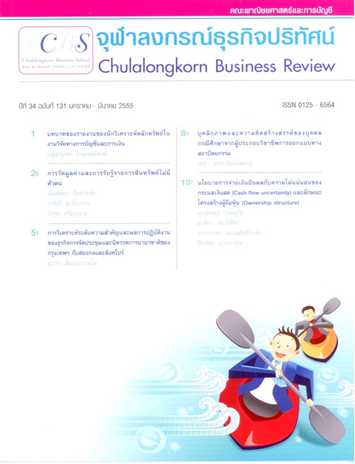การวัดมูลค่าและการรับรู้รายการสินทรัพย์ไม่มีตัวตน
Main Article Content
Abstract
บทคัดย่อ
มาตรฐานการบัญชีฉบับที่ 38 เรื่อง สินทรัพย์ไม่มีตัวตน อนุญาตให้รับรู้สินทรัพย์ไม่มีตัวตนที่เกิดขึ้นภายในกิจการภายใต้เงื่อนไขที่จำกัด เนื่องจากความไม่แน่นอนในประโยชน์เชิงเศรษฐกิจในอนาคต หลักการในการวัดมูลค่าที่ปรากฏอยู่ในวรรณกรรมช่วยให้สามารถวัดมูลค่าได้ หลักการวัดมูลค่าของสินทรัพย์ไม่มีตัวตนดังกล่าวตั้งอยู่บนพื้นฐานของวิธีการวัดมูลค่าด้วยรายได้ และวิธีการวัดมูลค่าด้วยราคาทุน
บทความนี้มีวัตถุประสงค์เพื่อ (1) นำเสนอหลักการรับรู้รายการสินทรัพย์ไม่มีตัวตน (2) นำเสนอหลักการในการวัดมูลค่าของสินทรัพย์ไม่มีตัวตน (3) นำเสนอหลักฐานเชิงประจักษ์ว่ารายจ่ายบางรายการก่อให้เกิดประโยชน์เชิงเศรษฐกิจในอนาคตที่สามารถวัดมูลค่าได้ในเชิงวิชาการ และสามารถแยกจากต้นทุนในการพัฒนาธุรกิจโดยรวม (4) นำเสนอประเด็นเกี่ยวกับลักษณะเชิงคุณภาพที่ทำให้ข้อมูลบัญชีมีประโยชน์ในการตัดสินใจ และ (5) ผลกระทบจากปัญหาความไม่เท่าเทียมกันของข้อมูล ในสภาพแวดล้อมที่การรับรู้รายการสินทรัพย์ไม่มีตัวตนมีข้อจำกัด
คำสำคัญ : สินทรัพย์ไม่มีตัวตน การวัดมูลค่า
Abstract
The Thai Accounting Standards No. 38, Intangible Assets, permit the recognition of internally-generated intangible assets under limited circumstances because of uncertainties involving future economic benefits. Valuation principles present in the literature allow the measurement of intangible asset value. Such principles include income and cost approaches to fair value determination.
The objectives of this paper are (1) to present the recognition principles for intangible assets, (2) to demonstrate the principles applicable to intangible asset valuation, (3) to present empirical evidence that future economic benefits from certain expenditures can be measured and that the value can be separated from other business development expenditures, (4) to provide arguments on the decision-usefulness of accounting information, and (5) consequences of information asymmetry problems in the environment in which intangible asset recognition are subject to stringent conditions.
Keywords : Intangible Assets, Measurement
Article Details
Opinions and discussions in papers published by the Creative Business and Sustainability Journal (CBSJ) are deemed as personal opinions and the responsibility of the writers. They are not the opinions or responsibility of the Chulalongkorn Business School of Chulalongkorn University.
Papers, content, information etc. appearing in the Journal are deemed to be the copyright property of the Chulalongkorn Business School of Chulalongkorn University. Anybody or any organization that wishes to publish any part of them or use them in any way must obtain written permission from the Chulalongkorn Business School, Chulalongkorn University.


